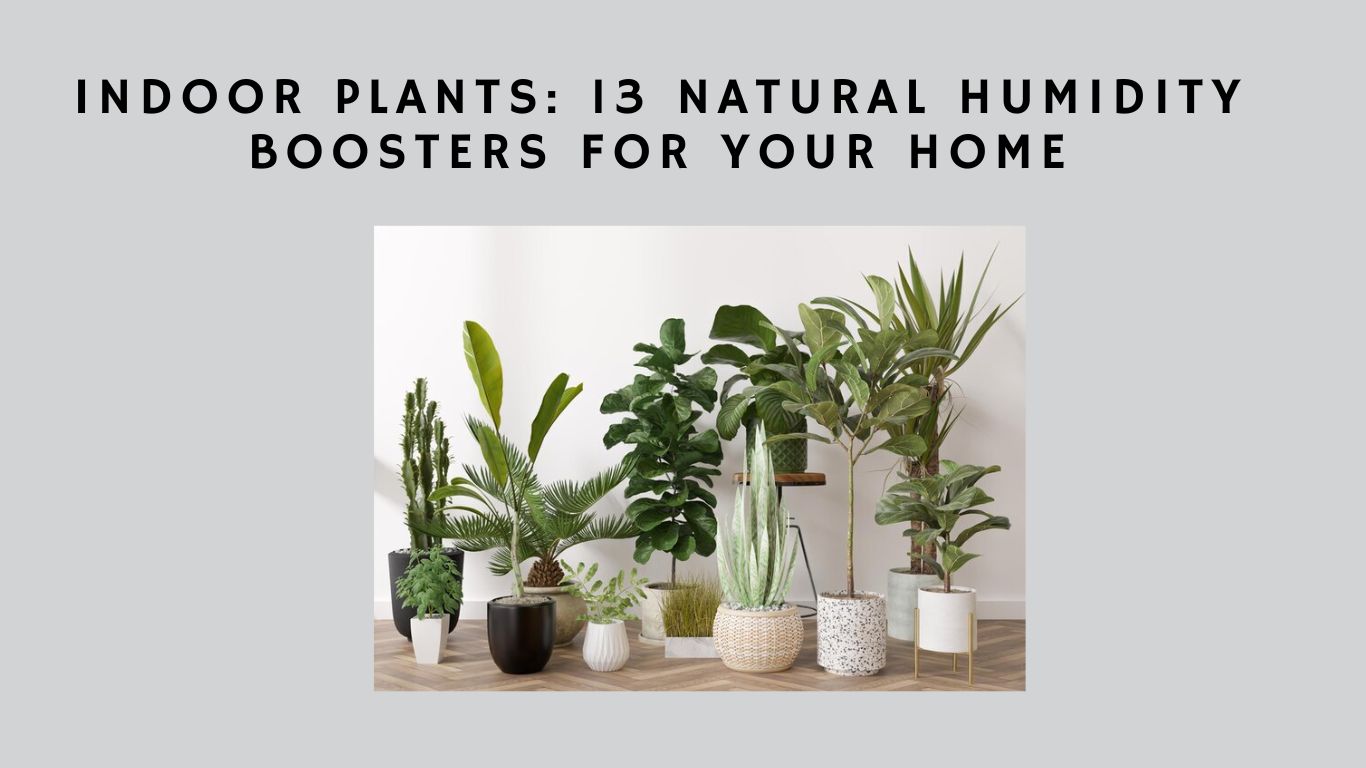Have you ever wondered why some houses feel so dry and uncomfortable while others always seem to have a pleasant level of humidity? The secret lies in one simple yet effective solution: indoor plants. Incorporating these botanical wonders into your home not only enhances its beauty but also helps regulate the moisture content in the air.
If you’re tired of suffering from dry skin, irritated sinuses, or static electricity shocks every time you touch something metal, it’s time to introduce nature’s own humidifiers into your living space.
In this article, we will identify 13 remarkable indoor plants that can naturally boost the humidity levels in your home and transform it into a cozy oasis.
Spider Plant

Spider plants are a popular choice for increasing humidity in your home. With their cascading green leaves and easy care requirements, spider plants not only add a touch of beauty to your living space but also help create a more comfortable environment.
One of the best things about spider plants is their ability to propagate easily. This means that once you have one spider plant, you can easily grow more without much effort. Spider plant propagation can be done by simply placing the plantlet, which is a small offshoot of the mother plant, into a pot with soil. Within a few weeks, roots will start to develop, and soon you’ll have a new spider plant to add to your collection.
When it comes to caring for spider plants, they’re quite resilient and can tolerate a wide range of light conditions. However, they thrive best in bright, indirect light. If you have a room with low light, don’t worry.
Spider plants can still survive in low light conditions, although their growth may be slower. To keep your spider plant healthy in low light, make sure to place it near a window where it can receive some filtered sunlight. Avoid placing it in direct sunlight as this can scorch the leaves.
To provide optimal care for your spider plant, it’s important to water it correctly. Spider plants prefer to be kept slightly moist but not overly wet. Water the plant when the top inch of soil feels dry to the touch. Be careful not to overwater as this can lead to root rot.
Spider plants are also known for their ability to purify the air, making them a great addition to any home. So, if you’re looking for a low-maintenance plant that can increase humidity and add a touch of green to your space, a spider plant is the perfect choice.
Boston Fern

One humidity-boosting plant you should consider for your home is the Boston Fern. Not only does it add a touch of natural beauty to your indoor space, but it also provides numerous benefits for your indoor air quality.
When it comes to optimal Boston Fern care, there are a few key things to keep in mind. First, this fern thrives in indirect sunlight, so placing it near a north-facing window or in a spot with filtered light is ideal. It also prefers a consistently moist environment, so be sure to water it regularly. However, avoid overwatering as this can lead to root rot.
One of the most impressive benefits of the Boston Fern is its ability to improve indoor air quality. As a natural humidifier, it releases moisture into the air, increasing the humidity levels in your home. This is particularly beneficial during dry winter months or in rooms with low humidity.
But the advantages of the Boston Fern don’t stop there. It also helps to remove toxins from the air, such as formaldehyde, xylene, and toluene. These harmful substances can be found in common household items like carpets, furniture, and cleaning products.
By having a Boston Fern in your home, you can create a healthier and more comfortable living environment for you and your family.
To summarize, the Boston Fern is not only a beautiful addition to your indoor space but also a natural humidifier and air purifier. By providing optimal care and placing it in the right spot, you can enjoy the benefits of improved humidity and cleaner air.
| Optimal Boston Fern Care | Benefits of Boston Fern for Indoor Air Quality |
|---|---|
| Indirect sunlight | Improves indoor air quality |
| Consistently moist | Removes toxins from the air |
| Avoid overwatering | Natural humidifier |
Peace Lily

If you’re looking for a low-maintenance plant that can help boost the humidity in your home, the Peace Lily is an excellent choice.
Not only does it add a touch of elegance to any space with its glossy green leaves and white flowers, but it also has the ability to increase the moisture levels in the air.
The Peace Lily thrives in environments with higher humidity, making it a perfect addition to your home to create a more comfortable and healthy living environment.
Optimal Peace Lily Care
To ensure optimal care for your Peace Lily, it’s important to follow these guidelines.
When it comes to peace lily propagation, the best method is through division. Simply remove the plant from its pot and carefully separate the root clumps into smaller sections, each with a few leaves and roots. This will help promote new growth and ensure a healthy plant.
As for lighting requirements, peace lilies prefer bright, indirect light. They can tolerate lower light conditions, but too much direct sunlight can scorch their leaves. Place your peace lily near a north or east-facing window for best results.
If you notice your plant’s leaves turning yellow or brown, it may be receiving too much light. Adjust its placement accordingly to maintain its health and beauty.
Humidity Benefits for Peace Lily
Boost the humidity for your Peace Lily to enjoy its full benefits.
Peace Lilies aren’t only known for their beautiful white flowers and air-purifying abilities, but also for their ability to thrive in high humidity environments. By providing the ideal humidity levels, you can ensure that your Peace Lily remains healthy and vibrant.
The humid environment helps the plant to retain moisture, preventing the leaves from drying out and becoming brown or crispy. Increased humidity also promotes the plant’s overall growth and keeps it looking lush and green. Additionally, the higher humidity levels can help prevent pest infestations, as many common houseplant pests thrive in dry conditions.
To maintain the optimal humidity for your Peace Lily, you can mist the leaves regularly, place a humidifier nearby, or group it with other plants to create a microclimate of moisture.
English Ivy

You can enhance the humidity in your home by incorporating English Ivy as one of your natural indoor plants. English Ivy, also known as Hedera helix, isn’t only a beautiful addition to your home decor but also offers several benefits for your indoor environment. Here are some reasons why having English Ivy in your home is a great idea:
- Improved air quality: English Ivy can help purify the air by removing toxins such as formaldehyde, benzene, and trichloroethylene. Breathing cleaner air can contribute to a healthier and more comfortable living space.
- Natural humidifier: English Ivy has the ability to increase the humidity in your home, making it an excellent choice for those living in dry climates or during the winter months when the air tends to be drier. This can help alleviate dry skin, dry throat, and other discomforts associated with low humidity.
- Reduced mold and allergens: English Ivy has been found to reduce mold spores and airborne allergens, making it beneficial for individuals with allergies or respiratory conditions. By having English Ivy in your home, you can create a healthier environment for yourself and your family.
- Noise reduction: The dense foliage of English Ivy can help absorb sound, acting as a natural noise barrier. This can be particularly useful if you live in a noisy neighborhood or near a busy street.
- Aesthetically pleasing: English Ivy is a visually appealing plant that can add a touch of elegance and greenery to any room. Its cascading vines can be trained to climb walls or hang from baskets, creating a sense of tranquility and beauty in your living space.
Now that you know the benefits of having English Ivy in your home, here are some tips for successfully growing it indoors:
- Light: English Ivy thrives in medium to bright indirect light. Place it near a window that receives filtered sunlight for optimal growth.
- Watering: Keep the soil evenly moist but not soggy. Avoid overwatering, as this can lead to root rot. Allow the top inch of soil to dry out slightly before watering again.
- Temperature and humidity: English Ivy prefers cooler temperatures between 50-70°F (10-21°C) and moderate to high humidity levels. Mist the leaves occasionally or place a humidifier nearby to increase humidity.
- Pruning: Regularly trim back the vines to promote bushier growth and prevent them from becoming too leggy. This will help maintain a compact and attractive appearance.
- Fertilization: Feed your English Ivy with a balanced liquid fertilizer diluted to half-strength during the growing season (spring and summer) to provide it with essential nutrients.
Areca Palm

Areca Palm isn’t only a beautiful addition to your home decor, but it also offers a range of health benefits.
This tropical plant acts as a natural humidifier, releasing moisture into the air and helping to alleviate dryness in your home.
Additionally, caring for an Areca Palm is relatively easy, requiring moderate sunlight and regular watering.
Health Benefits of Areca Palm
The health benefits of the Areca Palm include improving air quality and reducing stress in your home. This indoor plant isn’t only a beautiful addition to your space, but it also has numerous benefits for your well-being.
Here are five reasons why you should consider adding an Areca Palm to your indoor garden:
- Indoor air purification: The Areca Palm is known for its ability to filter and cleanse the air, removing toxins and pollutants.
- Natural humidifier: This plant releases moisture into the air, increasing humidity levels and helping to alleviate dryness.
- Enhanced breathing: The Areca Palm releases oxygen and absorbs carbon dioxide, promoting better air circulation and improving respiratory function.
- Stress reduction: Being surrounded by nature has a calming effect on the mind and body, reducing stress and promoting a sense of tranquility.
- Improved focus and productivity: Studies have shown that having indoor plants, like the Areca Palm, in your environment can enhance concentration and productivity.
With its air-purifying properties and stress-reducing benefits, the Areca Palm is a fantastic addition to any home, creating a healthier and more harmonious living space.
Care Tips for Areca Palm
To properly care for the Areca Palm, ensure that you provide it with the right amount of sunlight, water, and regular fertilization.
This tropical plant thrives in bright, indirect light, so place it near a window where it can get filtered sunlight. However, be cautious of exposing it to direct sunlight as it can scorch the leaves.
Water the Areca Palm when the top inch of soil feels dry, making sure not to overwater it as this can lead to root rot.
The best indoor humidity levels for the Areca Palm range between 40% and 50%, mimicking its natural habitat. You can increase humidity by misting the leaves or placing a tray of water nearby.
Remember to fertilize the plant every two to three months during the growing season to keep it healthy and vibrant.
Snake Plant

One natural humidity booster for your home is the snake plant. Also known as Sansevieria, the snake plant is a popular choice among plant enthusiasts for its numerous benefits and ease of care.
Here’s why you should consider adding a snake plant to your indoor space:
- Air purification: Snake plants are known for their ability to purify the air by removing toxins such as formaldehyde, benzene, and xylene. This can promote a healthier environment and reduce the risk of respiratory issues.
- Low maintenance: If you’re looking for a low-maintenance plant, the snake plant is perfect for you. It can thrive in various light conditions, including low light, and doesn’t require frequent watering. This makes it an ideal choice for busy individuals or those who are new to plant care.
- Increased oxygen production: Like other plants, snake plants release oxygen during photosynthesis. Having a snake plant in your home can help increase oxygen levels, which can improve overall air quality and create a more refreshing atmosphere.
- Stress reduction: Research has shown that indoor plants, including snake plants, can help reduce stress and anxiety levels. The presence of greenery in your living space can create a sense of calm and tranquility, promoting a more peaceful and relaxing environment.
- Aesthetically pleasing: Snake plants come in a variety of shapes, sizes, and colors, making them a versatile choice for any home decor style. Whether you prefer tall, sword-like leaves or compact rosettes, there’s a snake plant that will suit your taste and enhance the visual appeal of your space.
With its numerous benefits and minimal care requirements, the snake plant is an excellent addition to any indoor environment. By incorporating this resilient plant into your home, you can enjoy improved air quality, reduced stress levels, and a touch of natural beauty.
Rubber Plant

If you’re looking to further boost the humidity in your home, consider adding a rubber plant to your indoor space. The rubber plant, also known as Ficus elastica, is a popular choice among plant enthusiasts for its ability to thrive in low light conditions and its impressive air-purifying qualities.
Taking care of a rubber plant is relatively easy, making it a great option for beginners.
When it comes to rubber plant care, there are a few key things to keep in mind. First, make sure to place your rubber plant in a spot with bright, indirect light. While it can tolerate low light conditions, it will grow best with some exposure to sunlight.
Secondly, water your rubber plant thoroughly but allow the top few inches of soil to dry out between waterings. Overwatering can lead to root rot, so it’s important to strike a balance.
Having a rubber plant in your home offers a range of benefits. Not only does it help to increase humidity levels, but it also purifies the air by removing toxins such as formaldehyde and benzene. This can improve the overall air quality in your home, making it a healthier environment for you and your family.
In addition to its air-purifying qualities, the rubber plant is also known for its aesthetic appeal. With its large, glossy leaves and tall, upright growth habit, it adds a touch of greenery and elegance to any space.
The rubber plant is also known to be a symbol of abundance and wealth, making it a popular choice for those who desire a sense of prosperity and belonging in their home.
Aloe Vera
If you’re looking to further boost the humidity in your home, consider adding an aloe vera plant to your indoor space. Not only does this plant have numerous benefits for your health and well-being, but it also acts as a natural humidifier.
Here are some reasons why you should consider incorporating an aloe vera plant into your home:
- Aloe vera has air-purifying properties, helping to remove toxins and improve the air quality in your home. This can have a positive impact on your overall health and well-being.
- The gel inside the aloe vera plant is known for its soothing properties. It can help alleviate skin irritations, and burns, and even promote the healing of minor wounds.
- Aloe vera is a low-maintenance plant, making it perfect for those who may not have a green thumb. It requires minimal watering and can thrive in various light conditions.
- The plant’s leaves are filled with a gel-like substance that contains essential vitamins and minerals. Consuming aloe vera juice can help boost your immune system, aid digestion, and promote healthy skin.
- Aloe vera plants are known to reproduce quickly, producing offshoots or ‘pups’ that can be repotted and shared with friends and family. This can create a sense of belonging and community as you share the benefits of this versatile plant.
To care for your aloe vera plant, make sure to place it in a sunny spot with indirect light and water it sparingly, allowing the soil to dry out between waterings. Be cautious not to overwater, as this can lead to root rot. With proper care, your aloe vera plant won’t only add beauty to your indoor space but also provide numerous benefits for you and your home.
Chinese Evergreen

If you’re looking for a low-maintenance plant that can boost humidity levels in your home, the Chinese Evergreen is an excellent choice. This plant thrives in indoor environments and is known for its ability to enhance air quality.
Not only does it add a touch of green to your space, but it also helps create a healthier living environment.
Low-Maintenance Humidity Booster
To boost the humidity in your home with minimal effort, consider adding a Chinese Evergreen plant. This low-maintenance plant option not only adds a touch of green to your space but also helps increase the humidity levels naturally.
Here are five reasons why Chinese Evergreen is an excellent choice for boosting humidity in your home:
- Air purification: Chinese Evergreen not only adds moisture to the air but also helps purify it by removing toxins and pollutants.
- Low light requirements: This plant thrives in low light conditions, making it perfect for rooms with minimal sunlight.
- Easy to care for: Chinese Evergreen is known for its resilience and ability to tolerate neglect, making it an ideal choice for those who are new to plant care.
- Long-lasting foliage: The attractive leaves of Chinese Evergreen can last for several months, adding beauty to your space.
- Variety of colors and patterns: With its wide range of foliage colors and patterns, Chinese Evergreen offers options to suit any interior design style.
Ideal for Indoor Environments
For boosting humidity in your home, Chinese Evergreen is an ideal choice due to its ability to thrive in indoor environments. This versatile plant not only adds beauty to your space but also helps to create a more comfortable and healthy living environment.
Chinese Evergreen is a low-maintenance plant that can tolerate low-light conditions, making it a perfect option for those looking for low-light alternatives. Its attractive foliage comes in various shades of green, with some varieties featuring stunning patterns and variegations.
This makes Chinese Evergreen not only a functional humidity booster but also a decorative addition to your home.
With its ability to adapt to different conditions and its aesthetic appeal, Chinese Evergreen is the perfect choice for creating a welcoming and comfortable atmosphere in your indoor space.
Enhances Air Quality
Chinese Evergreen significantly improves the air quality in your home by removing harmful toxins and pollutants. This beautiful and low-maintenance plant acts as a natural air purifier, making your living space healthier and more comfortable.
Here are five reasons why Chinese Evergreen is a must-have for air purification:
- Removes formaldehyde: Chinese Evergreen has the ability to absorb and break down formaldehyde, a common indoor pollutant found in furniture and cleaning products.
- Filters benzene: This plant effectively filters benzene, a harmful chemical present in cigarette smoke and certain household items.
- Clears trichloroethylene: Chinese Evergreen removes trichloroethylene, a toxic compound commonly found in paint thinners and adhesives.
- Eliminates xylene: This plant helps eliminate xylene, a solvent present in printing inks and paints, which can cause headaches and respiratory problems.
- Enhances oxygen levels: Chinese Evergreen releases oxygen during photosynthesis, improving the air quality and promoting a sense of well-being.
Bamboo Palm

Boost the humidity in your home with the natural beauty of a Bamboo Palm. This tropical plant, also known as Chamaedorea seifrizii, not only adds a touch of elegance to your living space but also offers numerous benefits.
Bamboo palm care is relatively easy, making it a popular choice for those looking to enhance the ambiance of their home while improving indoor air quality.
One of the key benefits of having a bamboo palm is its ability to increase humidity levels. As a natural humidifier, this plant releases moisture into the air through a process called transpiration. Transpiration is the movement of water from the plant’s roots to its leaves, where it’s then released into the surrounding environment.
By having a bamboo palm in your home, you can create a more comfortable living space, especially during dry winter months or in areas with low humidity.
In addition to boosting humidity, bamboo palms have been found to purify the air by removing harmful toxins. The foliage of the plant acts as a natural air filter, removing pollutants such as formaldehyde, benzene, and carbon monoxide.
These toxins can be found in common household items such as cleaning products, furniture, and carpets. By having a bamboo palm in your home, you can breathe easier knowing that the air you’re inhaling is cleaner and healthier.
Caring for a bamboo palm is relatively straightforward. It prefers bright but indirect light, so placing it near a north or east-facing window is ideal.
This plant also thrives in well-draining soil and should be watered when the top inch of soil feels dry. Regular fertilization during the growing season will help promote healthy growth.
Philodendron

One great option for increasing humidity in your home is the Philodendron plant. Not only does this beautiful plant add a touch of green to your space, but it also offers numerous benefits for improving air quality. Here’s how you can care for your Philodendron in low-humidity environments:
- Misting: Regularly misting your Philodendron’s leaves with water can help create a more humid environment around the plant. This simple act can provide a much-needed boost of moisture in dry spaces.
- Grouping: Placing your Philodendron alongside other plants can create a microclimate with increased humidity. The collective transpiration of multiple plants in close proximity helps to raise the moisture level in the air.
- Pebble Tray: Fill a shallow tray with water and place it beneath your Philodendron’s pot. As the water evaporates, it adds moisture to the surrounding air. Just make sure the water level doesn’t reach the bottom of the pot to avoid overwatering.
- Humidifier: Consider using a humidifier in the room where your Philodendron is located. This device will release moisture into the air, benefiting both your plant and your overall comfort.
- Bathroom Placement: Philodendrons thrive in humid environments, so placing them in the bathroom can be a great strategy. The natural humidity from showers and baths will provide the necessary moisture for your plant’s health.
Dracaena

To increase humidity in your home, consider adding a Dracaena plant. Dracaena is a popular choice for indoor plants due to its ability to thrive in various conditions and its air-purifying properties. There are several varieties of Dracaena to choose from, each with its own unique appearance and care requirements.
One of the most common Dracaena varieties is Dracaena marginata, also known as the Dragon Tree. This plant features long, slender leaves that are green with red or purple edges. It can tolerate low light conditions, making it a great choice for those with limited natural light in their homes. Dracaena marginata prefers well-draining soil and should be watered when the top inch of soil feels dry.
Another popular Dracaena variety is Dracaena fragrans, commonly known as the Corn Plant. This plant has broad, arching leaves that are green with yellow stripes running down the center. It’s a low-maintenance plant that can tolerate low light conditions and infrequent watering.
Dracaena fragrans prefers slightly acidic soil and should be fertilized every two to three months during the growing season.
When caring for Dracaena plants, it’s important to provide them with the right conditions to thrive. They prefer bright, indirect light but can tolerate lower light levels. They should be watered when the top inch of soil feels dry, but be careful not to overwater as this can lead to root rot.
Dracaena plants also benefit from regular dusting of their leaves to keep them clean and allow for optimal photosynthesis.
Pothos

If you’re looking to further enhance the humidity in your home, consider incorporating Pothos into your indoor plant collection. Pothos, also known as Devil’s Ivy, is a popular houseplant that not only adds beauty to your space but also offers several benefits for improving indoor air quality.
Here are some key reasons why Pothos is an excellent choice for your home:
- Easy to care for: Pothos is a low-maintenance plant that thrives in various light conditions, making it perfect for beginners or busy individuals. It can tolerate low light levels and irregular watering, making it a versatile addition to any home.
- Air purifying properties: Pothos is known for its ability to remove toxins, such as formaldehyde, benzene, and xylene, from the air. These harmful substances can be found in everyday household items like cleaning products, furniture, and carpets. By having Pothos in your home, you can effectively improve the air quality and create a healthier environment for you and your family.
- Natural humidifier: Pothos has large, lush leaves that release moisture into the air through a process called transpiration. This natural humidifying effect can help combat dryness in your home, especially during the winter months when the air tends to be drier. The increased humidity can alleviate dry skin, and respiratory issues, and even reduce the risk of infections.
- Versatile decor: Pothos comes in various leaf colors and patterns, including golden, variegated, and neon green. This diversity allows you to choose the perfect Pothos variety that complements your home decor and brings a sense of style and warmth to any room.
- Positive energy: Pothos is believed to bring positive energy and good luck according to Feng Shui principles. By incorporating Pothos into your living space, you can create a harmonious and inviting atmosphere that promotes a sense of well-being and belonging.
Conclusion
Boosting humidity in your home can be as simple as adding a few indoor plants. Spider plants, Boston ferns, peace lilies, and English ivy are just a few natural options that can help create a more comfortable environment.
These plants not only add a touch of green to your space but also act as natural humidifiers, improving air quality and reducing dryness.
So, why not bring nature indoors and enhance the atmosphere of your home?
















